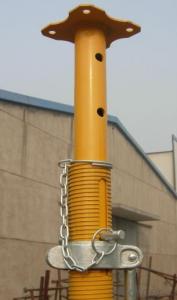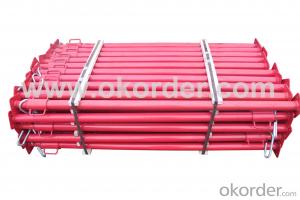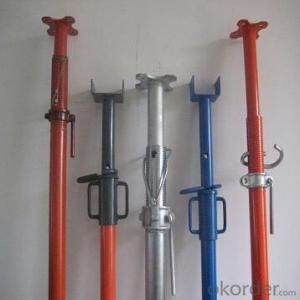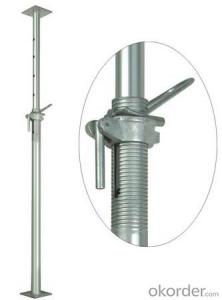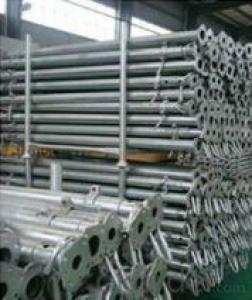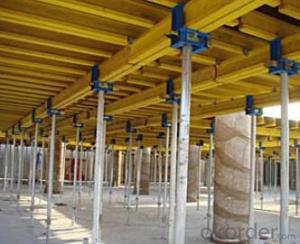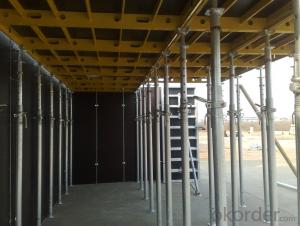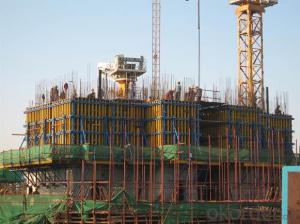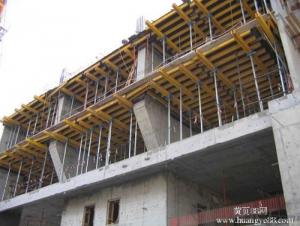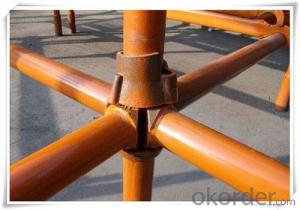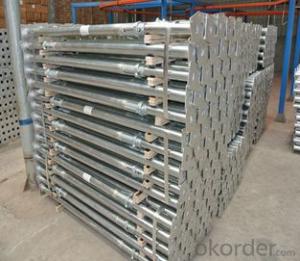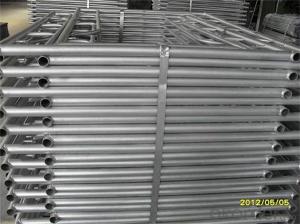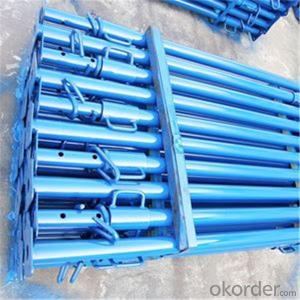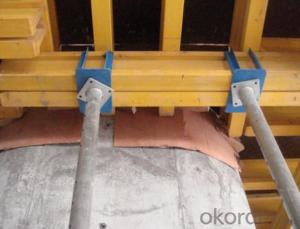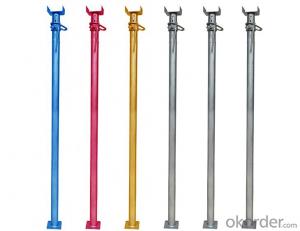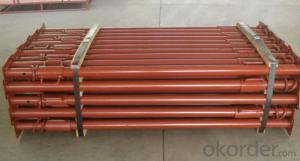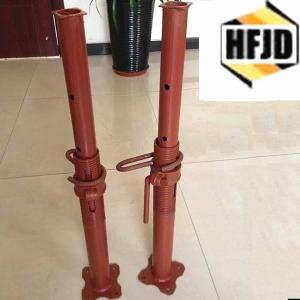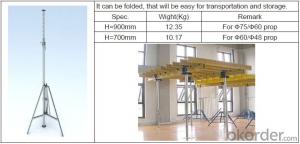Q235 material Painted Italian Type Scaffolding steel Prop
- Loading Port:
- China Main Port
- Payment Terms:
- TT OR LC
- Min Order Qty:
- -
- Supply Capability:
- -
OKorder Service Pledge
OKorder Financial Service
You Might Also Like
Quick Details
| Type: | |||||
| Scaffolding Part Type: | Scaffolding steel Prop: | material: | |||
| Inner Tube: | outer tube: | plate: | |||
| Weight: | Finish: | Delivery: | |||
| Price: |
Packaging & Delivery
| Packaging Detail: | n Pallets Or Customer Needs |
| Delivery Detail: | 30days |
Specifications
Q235 material Painted Italian Type Scaffolding steel Prop
1.Finish: Painted, Powder Coated,
Zinc Plate, Hot Dip Galvanized
Q235 material Painted Italian Type Scaffolding steel Prop
1.Material: Q235
2.Type: light type, heavy duty type
3. Sizes: according to customer's requirement
4.surface treatment: painted, powder coated, zinc plated, hot dip galvanized
5.Main market: Middle east, europe, north America, south America
6.Advantage: high quality, reasonable price, delivery in time, good package, and exellent services.
Specifications:
| Description | Length (m) | Outer Tube | Inner Tube | Weight (kgs) |
| Italian Type | 1.60-2.90 | 56 x 1.6m | 48.3 x 1.8m | 9.30 |
| 2.00-3.60 | 56 x 1.6m | 48.3 x 1.8m | 10.00 | |
| 2.20-4.00 | 56 x 1.6m | 48.3 x 1.8m | 11.00 |
- Q: Do you have a 400*16 model of steel support
- Yes, the support system is not limited to the material specifications, only with the force, and the role of the relevant
- Q: What are the common accessories or attachments available for steel props?
- Steel props have a range of common accessories and attachments available, which can enhance their functionality and versatility for different construction applications. Here are some of the most commonly used ones: 1. Adjustable heads: These are utilized to provide additional support and stability to the props. They can be adjusted to various angles and heights to accommodate different requirements. 2. Prop connectors: These connectors are employed to join multiple steel props together, creating a longer support system. They distribute the load evenly and create a stronger and more reliable structure. 3. Prop pins: These pins are inserted through the prop holes to secure them in place, preventing any accidental movement or collapse during construction activities. 4. Prop nuts and bolts: These accessories ensure secure fastening of different parts of the steel props. They provide additional reinforcement and stability to the system. 5. Prop base plates: Typically used to distribute the load over a larger surface area, these plates prevent sinking into soft ground or damaging the floor surface. They provide a stable foundation for the props. 6. Prop jacks: Hydraulic or mechanical devices that can be attached to the steel props to adjust their height as needed. They allow for easy and precise adjustment, making them suitable for uneven or sloping surfaces. 7. Prop braces: These braces reinforce the steel props and provide lateral support, especially in situations where there is a risk of lateral movement or instability. 8. Prop couplers: These devices connect steel props to other supporting structures, such as beams or columns. They allow for easy integration and provide a secure connection between different elements of the construction framework. In summary, these accessories greatly enhance the versatility, stability, and safety of steel props, making them a reliable choice for various construction projects.
- Q: Can steel props be used in the construction of temporary parking structures?
- Yes, steel props can be used in the construction of temporary parking structures. Steel props, also known as steel shores or steel supports, are commonly used in construction to provide temporary support and stability to structures during the construction process. They are adjustable and can be easily installed, making them ideal for temporary structures such as parking lots. Steel props are strong and durable, capable of supporting heavy loads, which is crucial in parking structures where vehicles will be parked. Additionally, steel props can be easily dismantled and reused, making them a cost-effective solution for temporary parking structures.
- Q: How do steel props compare to concrete slabs?
- Steel props and concrete slabs are two different components used in construction projects. Steel props, also known as steel supports or shoring systems, are temporary structural elements used to support loads during construction or renovation. They are adjustable, versatile, and can be easily installed and removed. On the other hand, concrete slabs are horizontal structural elements that form the base of a building or floor. They provide a solid foundation and can be reinforced with steel bars for added strength. Concrete slabs are permanent and require careful planning, formwork, and curing time. When comparing steel props to concrete slabs, it is essential to understand their different purposes. Steel props are primarily used for temporary support during construction activities, providing flexibility and adaptability. Concrete slabs, on the other hand, provide a permanent structural base for buildings or floors. Both steel props and concrete slabs play crucial roles in construction projects, but their functions are distinct. While steel props offer temporary support and flexibility, concrete slabs provide a durable and long-lasting foundation. Their usage depends on the specific requirements of the project and should be chosen accordingly.
- Q: What are the standard safety regulations for using steel props?
- The standard safety regulations for using steel props include ensuring proper installation and alignment, regular inspection for signs of damage or wear, using appropriate load-bearing capacity props for the specific application, and following manufacturer's guidelines for safe usage. Additionally, it is essential to provide adequate bracing and support to prevent accidental collapse, maintain a clear and safe working area, and train personnel on proper handling and dismantling procedures.
- Q: How do you calculate the required spacing between steel props?
- To ensure the safe and efficient support of a structure, several factors must be considered when calculating the required spacing between steel props. The following are the key steps involved in this calculation: 1. Start by determining the load that the steel props need to support, which includes the weight of the structure, any additional live loads, and any concentrated loads that may be present. 2. Next, assess the load-bearing capacity of the steel props being used. This information can typically be obtained from the manufacturer's specifications or load tables. It is important to consider both the maximum axial load and the maximum moment capacity of the props. 3. Divide the total load by the number of props to determine the load that each individual prop needs to support. Ensure that the individual prop load does not exceed the load-bearing capacity of the props. 4. Determine any spacing limitations based on the specific requirements of the project or the manufacturer's guidelines. These may include maximum and minimum spacing requirements, influenced by factors such as the prop's length, stability, or bracing requirements. 5. Take into account the deflection of the steel props under load. Typically, a maximum allowable deflection limit is provided by the manufacturer. Ensure that the spacing is such that the deflection of each prop remains within this limit. 6. Divide the maximum allowable deflection by the deflection of each prop under load to determine the number of props needed to achieve the desired spacing. It is important to ensure that the resulting number of props is practical and feasible within the given project constraints. 7. Finally, consider any additional factors that may impact the spacing calculation, such as wind loads, seismic loads, or any other relevant design considerations. Adjustments to the spacing calculation may be necessary to ensure the stability and safety of the structure. During the calculation process, it is crucial to consult with a structural engineer or a qualified professional to ensure accuracy and adherence to safety standards and local building codes.
- Q: Can steel props be used in construction of water tanks?
- Yes, steel props can be used in the construction of water tanks. Steel props are adjustable and reliable supports that can be used to provide temporary or permanent structural stability during the construction process. They are commonly used in various construction projects, including the construction of water tanks. Steel props are known for their strength and load-bearing capacity, which makes them suitable for supporting the weight of the tank walls and roof. Additionally, steel props can be easily adjusted to different heights, allowing for flexibility in the construction process. Therefore, steel props are a viable option for providing support during the construction of water tanks.
- Q: Are there any limitations to using steel props?
- Yes, there are some limitations to using steel props. Firstly, steel props are heavy and require manual handling or machinery for installation and removal. This can be time-consuming and labor-intensive, especially when working at heights or in confined spaces. Additionally, the weight of steel props may limit their use in certain applications where lightweight materials are preferred or where there are weight restrictions, such as in some construction or renovation projects. Secondly, steel props may not be suitable for all types of construction projects. They are typically used for temporary support during construction or renovation work, such as supporting walls, floors, or ceilings. However, in cases where the load-bearing capacity required is high, steel props may not provide sufficient support and alternative methods may be needed. Furthermore, steel props have limited adjustability. While they can be extended or shortened to some extent, their range of adjustability is limited compared to other support systems such as adjustable jacks or hydraulic shoring systems. This may pose limitations in situations where precise adjustment is necessary, or when working with uneven or sloping surfaces. Lastly, steel props are susceptible to corrosion if not properly maintained. Exposure to moisture, chemicals, or harsh environments can lead to rusting and weakening of the steel props over time. Regular inspection, cleaning, and appropriate protective measures are necessary to ensure their long-term effectiveness and safety. In summary, while steel props are widely used in construction for temporary support, they have limitations in terms of weight, suitability for certain applications, adjustability, and susceptibility to corrosion. These limitations should be carefully considered when selecting support systems for construction projects to ensure safety, efficiency, and cost-effectiveness.
- Q: Are steel props adjustable in both length and width?
- Generally, steel props are only adjustable in terms of length, not width. A screw thread mechanism is used to extend or retract the prop to the desired height. However, the distance between the two ends of the prop is typically fixed and cannot be altered. This is because the prop's width is determined by its design and construction, and modifying it could potentially impact its stability and ability to bear weight.
Send your message to us
Q235 material Painted Italian Type Scaffolding steel Prop
- Loading Port:
- China Main Port
- Payment Terms:
- TT OR LC
- Min Order Qty:
- -
- Supply Capability:
- -
OKorder Service Pledge
OKorder Financial Service
Similar products
Hot products
Hot Searches
Related keywords
